At Summer’s End is the official English translation of a freeware Japanese visual novel called Natsu no Owari ni. Natsu no Owari ni was developed by milkcat and released in Japan on December 17, 2003. At Summer’s End was translated by Mr. Chris St. Louis of Insani and contributed to the al|together 2006 visual novel translation festival on August 19, 2006. Below, I will review At Summer’s End as part of my project to review nearly 30 freeware visual novel translations that were submitted to the 2005, 2006, and 2008 al|together translation festivals.
You can learn more about my al|together project by reading my project introduction article. That article includes a running list of our completed al|together reviews. I have a dedicated collection post with links to all of our al|together articles, including reviews, essays, and short posts.

The entirety of At Summer’s End takes place in a single day. It follows two life-long friends and junior high school students, Kiichirou and Ayaka, on their first day back in school after summer vacation. We follow their banter, and we see Kiichirou think deeply about their long friendship after overhearing two classmates talking during the school day.
Note that this is a spoiler-free review beyond the fact that I note the existence of a plot twist toward the middle of the story. It can be read before or after reading At Summer’s End.
Related: See my humorous article on accidentally starting milkcat’s second visual novel, A Dream of Summer, instead of At Summer’s End.
At Summer’s End Details
English Release
| Title | At Summer’s End |
|---|---|
| Translator | Chris St. Louis |
| Release Date | August 19, 2006 |
| Engine | ONScripter-EN |
| Official Website | Insani; altogether 2006 |
| Visual Novel Database | VNDB Link |

Japanese Release
| Title | Natsu no Owari ni |
|---|---|
| Developer | milkcat (VNDB; Official) |
| Release Date | December 17, 2003 |
| Engine | NScripter |
| Download | Link |
Downloading and Running At Summer’s End
At Summer’s End is available as a direct download and torrent for Windows, Linux, and MacOS.
- al|together 2006 (Direct and Torrent)
- Insani (Torrent)
- Kaisernet (Windows direct)
At Summer’s End, like most (but not all) of the al|together visual novels, is written in ONScripter-EN. My review is based on running it natively on Linux, but I also tested installing the Windows version on top of WINE and I encountered no issues. Linux users should note that I had to run the latest ONScripter-EN executable in the game’s directory rather than the ONScripter executable that came in the directory. I wrote about two ways to do this in previous articles (see ONScripter-EN binary installed and moving binary into specific directory).
(In the event that the Linux and MacOS versions are ever unavailable, you may consult my guide on extracting the contents of the Windows .exe and using a different ONScripter-EN binary in the resulting directory.)
General overview of At Summer’s End
Insani, the circle behind the At Summer’s End localization project, provided the following description of the game:
At summer’s end, we move into new classes; the season changes into autumn; the leaves change color; but what of our friendships and our loves?
The description is not inaccurate in a technical sense, but it does not give one a good idea of what At Summer’s End is about or the story’s general tenor.
From the description of the game, I was expecting the setting to depict summer transitioning into autumn. However, while the game takes place on the first day of school after summer break, the setting is oppressively summery. One of the first jokes in the game is that the day the characters return from summer break is more distinctly summery than any of the days during summer break.
With respect to “but what of our friendships and our loves,” I am loath to say too much since this is a spoiler-free review for people who may be interested in reading At Summer’s End. It is technically true, but the story was generally more light-hearted than what I thought it would be going in.
At Summer’s End is the story of a day in the life of a boy and a girl, Kiichirou and Ayaka, who have been best friends and neighbors for as long as they could remember. We see them banter as they walk to school and hang out in school. There is an event at some point that causes Kiichirou to think about the meaning of his relationship with Ayaka, but I will refrain from going into specifics.
At Summer’s End Review
Below, I review the different components of At Summer’s End.
Estimated reading time
Visual Novel Database estimates that At Summer’s End takes about 40 minutes to read to 100% completion based on a small number of reader votes. I would guess that a reasonably fast reader who makes good use of save slots may err closer to 25-30 minutes. I was taking screenshots while reading, so I did not keep strict track of my reading time.
Game-play and structure
At Summer’s End has three in-game choices, meaning that it is not entirely devoid of player input like many of the visual novels that I have reviewed.

However, the choices are not ultimately meaningful. Each of the three choices affects a small amount of dialogue immediately following the choice, but the visual novel stays on course toward a single ending that is not affected by any of the three choices. However, specific choices are required in a pair of instances for unlocking two of At Summer’s End’s five CG images (more on that in a bit). It is possible to save before making a choice, which in turn makes it easy to see all of the game’s dialogue without needing to start from the beginning.
Visual presentation
There is one visual element that will catch potential readers’ attention – but before we address the design of the co-main character, Ayaka, I will take a look at some interesting distinguishing visual features in At Summer’s End.
UI elements
At Summer’s End has several visual elements and flourishes which set it apart from most of the freeware NScripter/ONScripter-EN visual novels from the al|together collection. It is most distinguished by its user interface elements. Text is confined to a text box, unlike many (but not all) of the NScripter/ONScripter-EN visual novels which display text starting from the top of the screen.

Attached to the text box are save, quick save, menu, view history, pause skipping, advance the text, and help buttons.
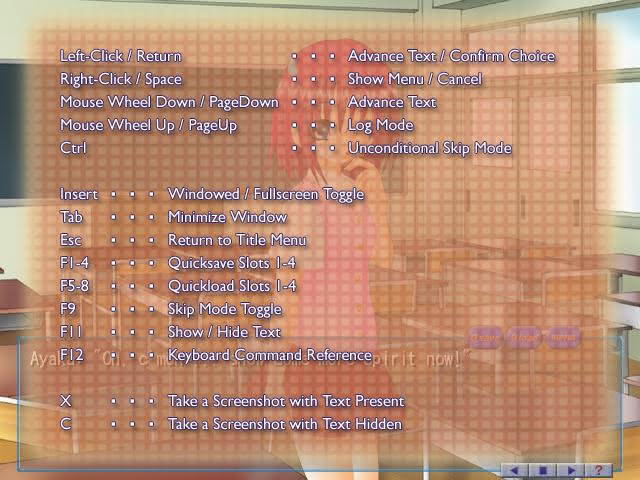
The menu is also quite stylish and feature-rich for a freeware game of the time and type:

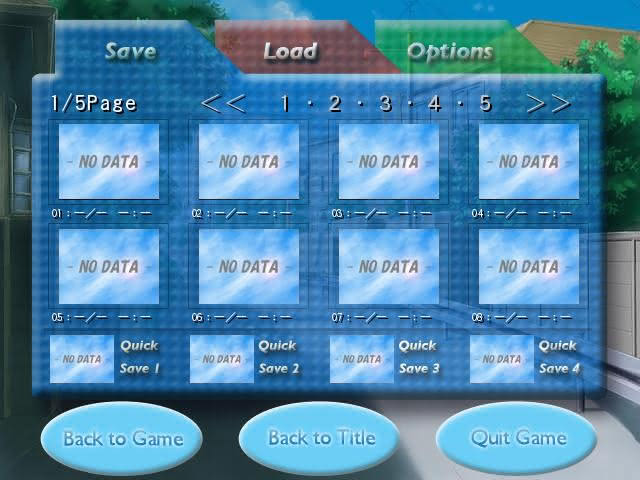
As we will see in a future review, milkcat would build on some of the UI-styling in At Summer’s End for the longer A Dream of Summer, which was also translated for al|together 2006.
Ayaka and the backgrounds
Ayaka, the co-main character, is the only character who is depicted in At Summer’s End. Her design is… interesting.
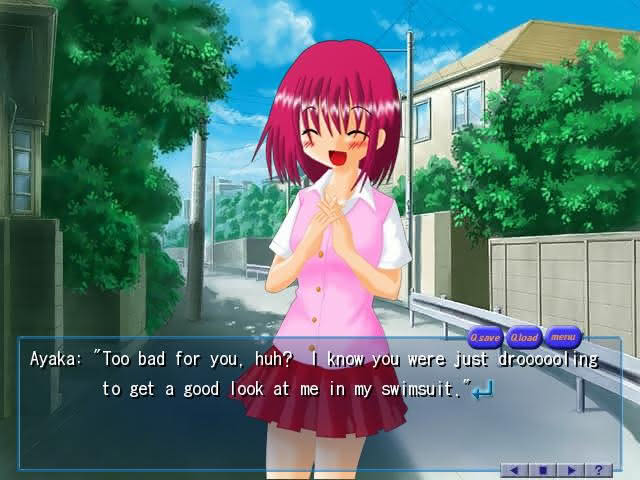
From the bright reddish-purple hair (the color is not commented upon, sadly) to the somewhat asymmetrical eyes, lack of nose, and blushed cheeks, Ayaka’s design is certainly distinct. I dare say that whether one discovers At Summer’s End here, on Insani, on the al|together 2006 site, or at the Visual Novel Database, Ayaka’s appearance will stand out more than the description of the game. Is that for better or worse?
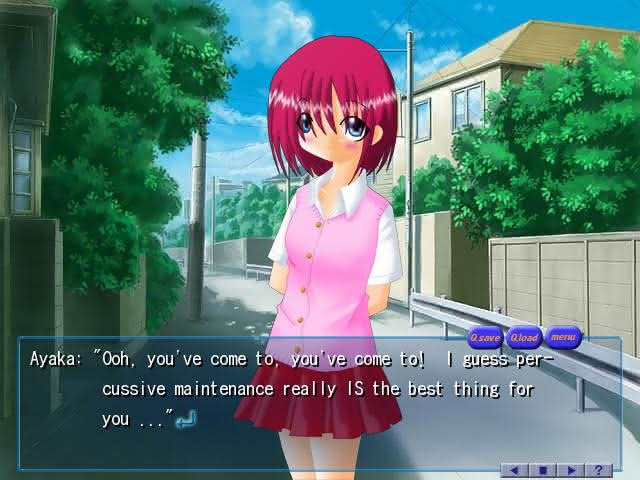
Ayaka has a hard-to-describe quasi-3D effect which makes her pop out from the backgrounds. Ayaka’s overall aesthetic is so odd that it serves as one of the more memorable aspects of At Summer’s End. While At Summer’s End is solid for what it is, it lacks a twist or defining moment that would make it memorable in any other respect, so I suppose one could charitably say Ayaka’s interesting face is a sort of calling card. Milkcat definitely improved on the character art for its next project, A Dream of Summer. Ayaka’s design is also somewhat similar (albeit lower quality) to the design of Minori, the co-protagonist in May Sky (an al|together 2008 translation), which I noted having mixed opinions about in my review.
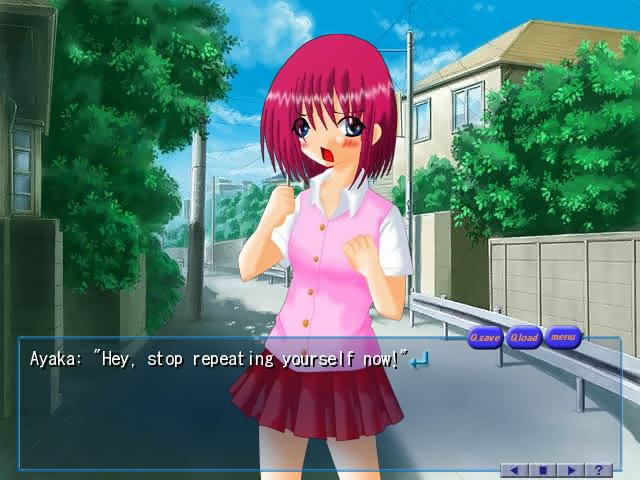
To the credit of At Summer’s End, Ayaka comes with a good variety of expressions and postures to animate her conversations. This is of no small importance in light of the fact that the entire game is more or less a conversation between Ayaka and Kiichirou.

I would not say that At Summer’s End was long enough for Ayaka to grow on me, but quality issues aside – the design is not entirely unfavorable for the visual novel’s overall impression.
The visual novel features five CG scenes, which is not a small number for its short length. All five CG scenes unsurprisingly feature Ayaka. We have seen visual novels where CG scenes are of a higher caliber than the regular character art – see my review of Visions from the Other Side for what may be the best example of a quality contrast. However, the Ayaka of the CG scenes looks very much the same as normal Ayaka – just with more pixels.

Completing the game gives the player access to a CG menu. However, note that at least one of the five CG images is only unlocked with a specific choice on one of the three choice selection events.
The best art in At Summer’s End are its chapter cards, of which there are three. Each of the three cards features a different pencil outline of Ayaka, which to be sure are the best depictions of her. The style is reminiscent of Red Shift (see review), albeit the Red Shift cards were far more striking.

Having covered Ayaka, we move to the backgrounds. While many NScripter/ONScripter-EN visual novels use photographs for backgrounds, At Summer’s End uses fully drawn backgrounds. The backgrounds include a street, school hallway, classroom, bathroom, roof, and river bank (note, the river bank may be a photograph with blur). They are all well done and serve their purposes, but none of the backgrounds are particularly memorable.
Music
Completing At Summer’s End opens up a jukebox which lists the game’s six songs in order.

(You can see what the music creator’s website looked like on December 13, 2003.)
A Flower In The Wind, the first track, loops too often in the visual novel’s long opening chapter – rendering it the weakest of the six tracks in context. The second and third tracks, Zephyr Blue, Orange Hue and Kitten’s Promenade have a distinctly summer vibe fitting the season of the story. Kitten’s Promenade reminded me of one of the songs in a non-al|together visual novel I reviewed, Save the Date. The fourth track, From The Convenience Store To Home, was a bit too dreary for At Summer’s End. Long-Cherished Dreams, the fifth track, sounds very much like generic visual novel background music. I did, however, like Faraway Memories -nostalgia-, which reminded me of some of the evening themes in the original Animal Crossing for GameCube.
Translation quality
I preface all of my translation reviews by noting that I am only reviewing how the game reads in English. I do not know how to read Japanese and in any event, I have only played the English version of At Summer’s End.
Mr. Chris St. Louis and Insani did a very good job producing a translation for At Summer’s End that reads very well in English. Although the story is simpler and less intricate than another of Mr. St. Louis’s translations that we have looked at, From the Bottom of the Heart, I dare say that it reads a touch better. I did not note any glaring examples of awkwardness or other issues which would have detracted from reading or understanding the story.
Writing and story quality
I noted in my review of the Usagi Drop anime series that the term slice of life is often abused through overuse, rendering the term almost meaningless. However, At Summer’s End is the kind of artistic production to which the term slice of life is best applied. It is, in its entirety, the story of a single school day in the lives of two middle school students who have been friends and neighbors as long as they can remember.
The long opening scene features Kiichirou and Ayaka walking to school together while bantering about nothing of great importance. They talk about their summer vacations, the hot weather, memories from their pasts, and things from their imaginations. Kiichirou is occasionally a bit crude and Ayaka is occasionally a touch violent (these points are sometimes, but not always, related). This long opening scene sets the tenor for the second chapter, which takes place during the school day, and the third and final chapter, which is set after school.
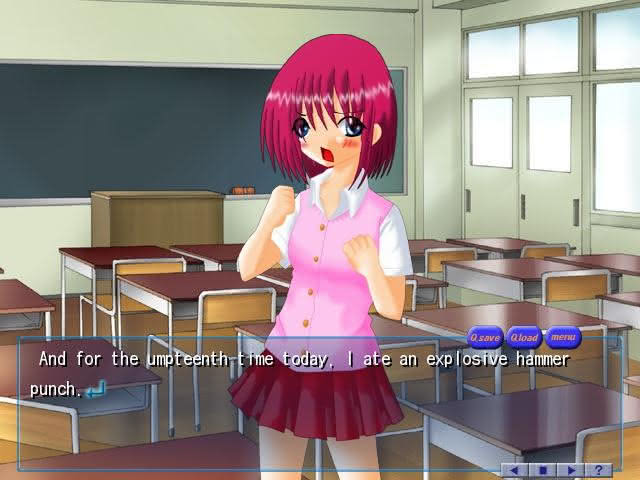
At Summer’s End injects a small amount of drama into the second act, which is ultimately resolved in the third. In the interest of maintaining the instant review as a spoiler-free effort, I will refrain from disclosing either the drama or its resolution. However, I will note that the fact that the drama introduced is something less than it first appears is made more obvious to readers who pay close attention to the dialogue and the dynamic between Kiichirou and Ayaka than it is clear to Kiichirou – which is a credit to the writing and delivery.
I also credit At Summer’s End for writing Kiichirou and Ayaka in mostly believable ways. That they are middle school students rather than high school students is obvious from the writing. They talk and behave in an age-appropriate manner. Ayaka, setting aside her tendency to quickly resort to violence, is a charming character.
At Summer’s End is thoroughly unambitious, which limits its ceiling. It never aspires to do more than to invite readers to follow a day in the life of two middle school friends. The twist in the second act is used to set up a big moment for the two friends in the third – something that will forever change their dynamic in some ways while leaving other things unchanged. Although At Summer’s End is limited by its lack of narrative ambition, it benefits from never biting off more than it could chew and from achieving its quaint objectives.
At Summer’s End is a competent piece, but not a memorable one.
Parting thoughts and recommendations
While I am not disclosing my al|together visual novel ranking until I complete my reviews, I will note that At Summer’s End falls in the middle of the 13 visual novels that I have reviewed thusfar. I have a feeling that it will be somewhere near the middle of the full al|together collection once I have played and considered all of the translations. It is not at all ambitious, but to its credit, it stays within itself and tells the story that it wants to tell in its short run-time.
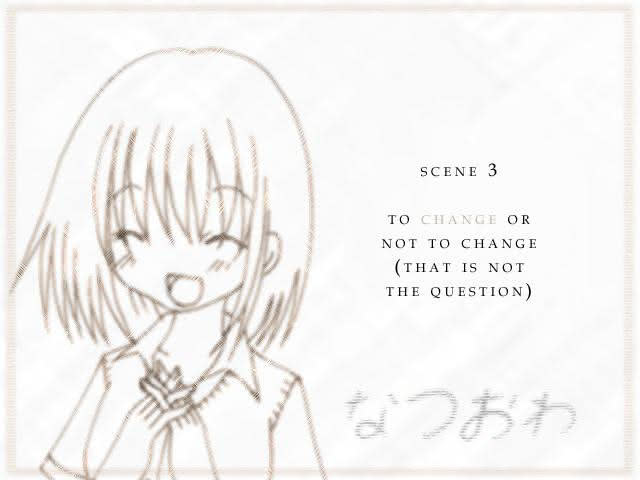
While I think that At Summer’s End is a well thought-out piece with its charming points, it is somewhat more difficult to recommend to general audiences than some of the al|together visual novels that I think are technically inferior to it (see example). Its subject matter – a day in the life of two middle school friends – is not for everyone, and at 30-40 minutes to read it is just long enough to constitute a small time investment. If you came away from my description of At Summer’s End thinking that it sounds worthwhile, there is a solid chance that you will enjoy the story enough to spend the time it takes to read. However, if my description does not sound interesting at all, there is little else in At Summer’s End to change your mind.
I do recommend At Summer’s End to people who are interested in visual novels. It is a solid, self-contained piece, and its design distinguishes it from other early-2000s NScripter visual novels. At Summer’s End is particularly interesting in the context of al|together because the 2006 festival not only featured it, but also the developer’s second visual novel, A Dream of Summer. Readers can see how milkcat evolved between projects and how A Dream of Summer builds on some of the themes of its predecessor.